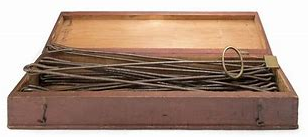acre, across
acre
The acre is a unit of land area used in the imperial and US customary systems. It is traditionally defined as the area of one chain by one furlong (66 by 660 feet), which is exactly equal to 10 square chains, or 43,560 square feet, and approximately 4,047 square metres, or about 40% of a hectare. Based upon the International yard and pound agreement of 1959, an acre may be declared as exactly 4,046.8564224 square metres. The acre was sometimes abbreviated ac, but was often spelled out as the word "acre".
chain:
Traditionally, in the Middle Ages, an acre was conceived of as the area of land that could be ploughed in one day by a team of eight oxen.
It is still a statute measure in the United States. Both the international acre and the US survey acre are in use, but they differ by only two parts per million. The most common use of the acre is to measure tracts of land.
The acre is commonly used in a number of current and former British Commonwealth countries by custom only. In a few it continues as a statute measure, although since 2010 not in the UK itself, and not since decades ago in Australia, New Zealand and South Africa. In many of those where it is not a statute measure, it is still lawful to "use for trade" if given as supplementary information and is not used for land registration.
Civil engineers and surveyors use various instruments (chains) for measuring distance. Other instruments used for measuring distance include tapes and bands. A steel band is also known as a "band chain".
The name furlong derives from the Old English words furh (furrow) and lang (long). Dating back at least to early Anglo-Saxon times, it originally referred to the length of the furrow in one acre of a ploughed open field (a medieval communal field which was divided into strips). The furlong (meaning furrow length) was the distance a team of oxen could plough without resting. This was standardised to be exactly 40 rods or 10 chains. The system of long furrows arose because turning a team of oxen pulling a heavy plough was difficult. This offset the drainage advantages of short furrows and meant furrows were made as long as possible. An acre is an area that is one furlong long and one chain (66 feet or 22 yards) wide. For this reason, the furlong was once also called an acre's length, though in modern usage an area of one acre can be of any shape. The term furlong, or shot, was also used to describe a grouping of adjacent strips within an open field.
六级/考研单词: acre, imperial, hectare, abbreviation, seldom, conceive, plough, ox, statute, unite, differ, million, tract, commonwealth, derive, medieval, rod, offset, usage, shot, adjacent
across
1. A chicken ran straight across the street.
2. There's Zack. Why don't you go across and say hi?
3. He walked across to where the girls were sitting.
4. The Yellow River is 20 km across at its widest point. I can't swim across.
5. There are many bridges across the Yellow River.
6. Penny lives across the hall.
7. The woman sitting across from the guys on the train is Xiao Yu.
8. TBBT is a TV series which became popular across many countries.
9. A science teacher is supposed to teach various subjects across the curriculum.
